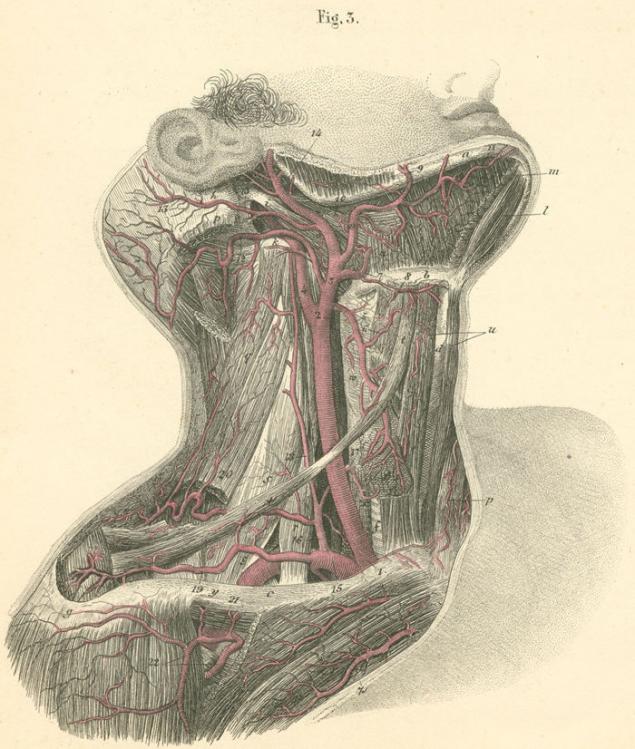548
As neck circumference is associated with metabolism indices and the risk of developing diseases
Neck circumference and your health.
We continue the conversation about the markers of health that can be easily measured independently. This marker is the neck. Today we will talk about how the neck circumference is associated with metabolism indices and the risk of developing several diseases.
The neck truly is a strategic part of the body. It passes through a number of key organs: the larynx, esophagus, trachea. And large vessels that carry blood to the brain. And fatty tissue, of course, which covers all of these bodies, the Americans conducted an experiment in which he concluded: the neck size of the person associated with the state of his heart and blood vessels. It turned out that people who have had cardiovascular problems had neck circumference above normal. This is due to blood glucose. The conclusion is: if your neck has increased in size, ought to have a cardiologist, so as not to bring themselves to a heart attack.

Neck — a marker of the metabolic syndrome Thus, the neck circumference is a good marker of obesity. According to Professor Jimmy Bell, one of the participants in the study were not overweight in General plays a role in our health, and where he raspolozhilas that the wider was the neck, the lower was the level of "good" cholesterol, and glucose levels in the blood increased in both men and women. The result was that the thickness of the neck is directly related to HDL, the thicker was the neck of the participants, the higher blood glucose and lower HDL level. With every extra three centimeters observed decrease in HDL in men and in women. The thickness of the neck, less accurately indicate the risk of cardio vascular disease than waist circumference. At the Congress of the American Association of clinical endocrinologists (American Association of Clinical Endocrinologists) presented the results of a study conducted at the Alexander University hospital in Sofia, Bulgaria, which had estimated the informative value of neck circumference as a marker of cardiovascular risk. The authors came to the conclusion that this parameter can accurately indicate the disturbances of metabolism, than the traditional anthropometric measurement of waist circumference, especially in patients with severe obesity.
It is established that, as a measure of subcutaneous fat of the upper body, which produces the highest amount of free fatty acids, the neck circumference may provide new information to create a profile of risk in a specific patient", this measurement is also a marker and a risk factor for obstructive sleep apnea syndrome. In women, the neck circumference is stronger than the waist circumference correlated with homeostatic model assessment of insulin resistance (HOMA-IR), as well as rating on a scale of Finnish Diabetes Risk Score (FINDRISC – Finnish diabetes risk assessment), levels of immunoreactive fasting insulin and triglycerides in the blood serum. In fact, there was no correlation between waist circumference and the last two indicators. But women have a waist circumference is better than neck circumference correlated with BMI and fasting glucose levels, and correlated with HbA1c (glycated hemoglobin), whereas neck circumference – no. In men, the neck circumference is also stronger than the waist circumference correlated with HOMA-IR (insulin resistance). However, as in women, waist circumference is stronger than the neck circumference was correlated with BMI, and it only correlated with fasting glucose levels. In women, the neck circumference of 34.5 cm or more had an 87% sensitivity for predicting metabolic syndrome compared to 82% 96.5 cm waist circumference. In men, waist circumference of 97 cm and above had a 97% sensitivity, whereas neck circumference 38.8 cm or higher had a 93% sensitivity for predicting metabolic syndrome. Need to measure both indicators? Dr. Kamenov said that, despite the fact that more literature data about the correlation of waist circumference with metabolic risk profiles and outcomes, and some of these associations was discovered here, its measurement in the clinic has some traps. It is difficult to measure in very fat people; if BMI more than 35 kg/m2 – waist circumference does not provide any additional information; measurement suffer from problems of standardization and variability during and between measurements. Neck circumference, on the other hand, is much easier to measure. Subcutaneous fat upper body, which she displays, is also a marker of obstructive sleep apnea syndrome. "They represent different things, so it's best to measure both indicators to improve the predictive value of anthropomorphic measurements," said Dr. Kamenov. Dr. Lieb noted that neck circumference may be an acceptable alternative for patients whose waist circumference is difficult and inconvenient to measure. "I don't think I would rule out the measurement of waist circumference completely. But there may be patients who have a neck circumference could replace waist circumference, due to the fact that its measurement is easier, or it may have additional benefits".

How to measure neck circumference? Typically, the neck circumference is measured between the middle cervical vertebrae and mid-neck in the front just below the ledge of rtanj. Simply put, measure the narrowest point of the neck. Indicators for guideline: in women, the neck circumference more than 34.5 (a more stringent rule – 32 cm) cm, men's neck circumference is more than 38,8 cm (more stringent measure – 35.5 cm.). The researchers defined exemplary rules for children. For example, for a 6-year-old boy from OSH wider than 28.5 cm, the risk of excess weight or obesity is almost 4 times higher than for a child of the same sex and age but with a smaller neck circumference. For girls the same age the upper limit of normal — 27,5 cm found that neck circumference positively correlated with systolic and diastolic blood pressure (r=0,261 0,250 and, respectively), the level of glucose in blood plasma fasting (r=0,177), triglycerides (r=0.240), total cholesterol (r=0,143); cholesterol low-density lipoproteins (r=0,088) and negatively correlated with the level of HDL cholesterol (r=-0,202) in men.
Based on these results the authors concluded that neck circumference is an independent predictor of cardiometabolic risk. However, the authors emphasize that one should not underestimate the role of measuring waist circumference and the ratio of the circumference of the waist and hips as markers of abdominal obesity.

Connection with changes of posture and the risk of apnea. Thickening of the neck may also be associated with impaired posture. Usually, this is combined with the protruding belly and other violations. The neck thickens and shortens. The growth of the person decreases. Neck circumference is an independent predictor of the development of sleep apnea. Sleep apnea in turn enhances the metabolic disorders and so on in a vicious circle.published Author: Andrey Blueskin
P. S. And remember, just changing your mind — together we change the world! ©
Source: www.beloveshkin.com/2015/07/okruzhnost-shei-i-vashe-zdorove.html
We continue the conversation about the markers of health that can be easily measured independently. This marker is the neck. Today we will talk about how the neck circumference is associated with metabolism indices and the risk of developing several diseases.
The neck truly is a strategic part of the body. It passes through a number of key organs: the larynx, esophagus, trachea. And large vessels that carry blood to the brain. And fatty tissue, of course, which covers all of these bodies, the Americans conducted an experiment in which he concluded: the neck size of the person associated with the state of his heart and blood vessels. It turned out that people who have had cardiovascular problems had neck circumference above normal. This is due to blood glucose. The conclusion is: if your neck has increased in size, ought to have a cardiologist, so as not to bring themselves to a heart attack.

Neck — a marker of the metabolic syndrome Thus, the neck circumference is a good marker of obesity. According to Professor Jimmy Bell, one of the participants in the study were not overweight in General plays a role in our health, and where he raspolozhilas that the wider was the neck, the lower was the level of "good" cholesterol, and glucose levels in the blood increased in both men and women. The result was that the thickness of the neck is directly related to HDL, the thicker was the neck of the participants, the higher blood glucose and lower HDL level. With every extra three centimeters observed decrease in HDL in men and in women. The thickness of the neck, less accurately indicate the risk of cardio vascular disease than waist circumference. At the Congress of the American Association of clinical endocrinologists (American Association of Clinical Endocrinologists) presented the results of a study conducted at the Alexander University hospital in Sofia, Bulgaria, which had estimated the informative value of neck circumference as a marker of cardiovascular risk. The authors came to the conclusion that this parameter can accurately indicate the disturbances of metabolism, than the traditional anthropometric measurement of waist circumference, especially in patients with severe obesity.
It is established that, as a measure of subcutaneous fat of the upper body, which produces the highest amount of free fatty acids, the neck circumference may provide new information to create a profile of risk in a specific patient", this measurement is also a marker and a risk factor for obstructive sleep apnea syndrome. In women, the neck circumference is stronger than the waist circumference correlated with homeostatic model assessment of insulin resistance (HOMA-IR), as well as rating on a scale of Finnish Diabetes Risk Score (FINDRISC – Finnish diabetes risk assessment), levels of immunoreactive fasting insulin and triglycerides in the blood serum. In fact, there was no correlation between waist circumference and the last two indicators. But women have a waist circumference is better than neck circumference correlated with BMI and fasting glucose levels, and correlated with HbA1c (glycated hemoglobin), whereas neck circumference – no. In men, the neck circumference is also stronger than the waist circumference correlated with HOMA-IR (insulin resistance). However, as in women, waist circumference is stronger than the neck circumference was correlated with BMI, and it only correlated with fasting glucose levels. In women, the neck circumference of 34.5 cm or more had an 87% sensitivity for predicting metabolic syndrome compared to 82% 96.5 cm waist circumference. In men, waist circumference of 97 cm and above had a 97% sensitivity, whereas neck circumference 38.8 cm or higher had a 93% sensitivity for predicting metabolic syndrome. Need to measure both indicators? Dr. Kamenov said that, despite the fact that more literature data about the correlation of waist circumference with metabolic risk profiles and outcomes, and some of these associations was discovered here, its measurement in the clinic has some traps. It is difficult to measure in very fat people; if BMI more than 35 kg/m2 – waist circumference does not provide any additional information; measurement suffer from problems of standardization and variability during and between measurements. Neck circumference, on the other hand, is much easier to measure. Subcutaneous fat upper body, which she displays, is also a marker of obstructive sleep apnea syndrome. "They represent different things, so it's best to measure both indicators to improve the predictive value of anthropomorphic measurements," said Dr. Kamenov. Dr. Lieb noted that neck circumference may be an acceptable alternative for patients whose waist circumference is difficult and inconvenient to measure. "I don't think I would rule out the measurement of waist circumference completely. But there may be patients who have a neck circumference could replace waist circumference, due to the fact that its measurement is easier, or it may have additional benefits".

How to measure neck circumference? Typically, the neck circumference is measured between the middle cervical vertebrae and mid-neck in the front just below the ledge of rtanj. Simply put, measure the narrowest point of the neck. Indicators for guideline: in women, the neck circumference more than 34.5 (a more stringent rule – 32 cm) cm, men's neck circumference is more than 38,8 cm (more stringent measure – 35.5 cm.). The researchers defined exemplary rules for children. For example, for a 6-year-old boy from OSH wider than 28.5 cm, the risk of excess weight or obesity is almost 4 times higher than for a child of the same sex and age but with a smaller neck circumference. For girls the same age the upper limit of normal — 27,5 cm found that neck circumference positively correlated with systolic and diastolic blood pressure (r=0,261 0,250 and, respectively), the level of glucose in blood plasma fasting (r=0,177), triglycerides (r=0.240), total cholesterol (r=0,143); cholesterol low-density lipoproteins (r=0,088) and negatively correlated with the level of HDL cholesterol (r=-0,202) in men.
Based on these results the authors concluded that neck circumference is an independent predictor of cardiometabolic risk. However, the authors emphasize that one should not underestimate the role of measuring waist circumference and the ratio of the circumference of the waist and hips as markers of abdominal obesity.

Connection with changes of posture and the risk of apnea. Thickening of the neck may also be associated with impaired posture. Usually, this is combined with the protruding belly and other violations. The neck thickens and shortens. The growth of the person decreases. Neck circumference is an independent predictor of the development of sleep apnea. Sleep apnea in turn enhances the metabolic disorders and so on in a vicious circle.published Author: Andrey Blueskin
P. S. And remember, just changing your mind — together we change the world! ©
Source: www.beloveshkin.com/2015/07/okruzhnost-shei-i-vashe-zdorove.html























